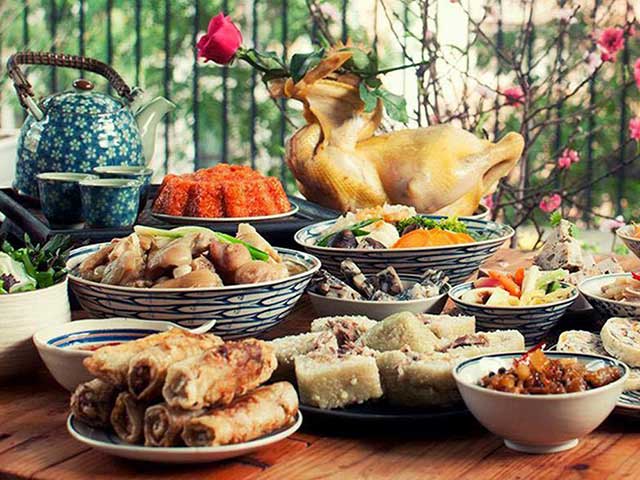The Night of New Year’s Eve, traditionally known as the “Tết Trừ Tịch,” is a significant time that marks the transition from the old year to the new. In this article, we will explore what Tết Trừ Tịch truly means and the key practices to observe during this sacred night.
What is Tết Trừ Tịch?
Tết Trừ Tịch, also referred to as the Thirtieth Night, is the period leading up to midnight, the moment when the old year gives way to the new year.
This night is the most sacred time of the year when families gather, preparing to welcome the new year with hopes for good fortune and bidding farewell to the old year.
The term “Trừ Tịch” consists of “trừ,” meaning to change or replace, and “tịch,” meaning night. “Trừ Tịch” translates to “the Night of Change,” a time of transition.
Tết Trừ Tịch is characterized by a dark, quiet night. “Lễ Trừ Tịch” (Trừ meaning to remove, Tịch meaning to lay down) signifies the “ceremony of laying down the old.” It is a night of stillness and sanctity, during which people strive to cleanse their minds and homes of negativity and prepare for a fresh start. In the hours leading up to midnight, people clean their surroundings, letting go of worries and disputes to embrace the new year with a clean slate.
The Ritual of Tết Trừ Tịch
The Tết Trừ Tịch ceremony takes place during the hour of Tý (from 11 PM to 1 AM), which encompasses one hour of the old year and one hour of the new. Families typically burn incense in front of their ancestral altars, offering traditional foods such as sticky rice and boiled rooster or sticky rice with pork leg.
During this ceremony, families express gratitude to the heavens and their ancestors, seek forgiveness from parents, reconcile with one another, let go of negativity, and commit to positive actions in the coming year. Even those without a specific religion or family gatherings often visit temples or sacred places during this holy moment to light incense and pray for blessings in the new year.

A colorful and abundant feast showcasing various traditional foods such as bánh chưng and boiled chicken…
Important Considerations for the Tết Trừ Tịch Ceremony
Traditionally, it is believed that there are twelve celestial officials, representing the twelve zodiac animals from the Year of the Rat to the Year of the Pig, who take turns overseeing earthly affairs. After each 12-year cycle, the first official resumes their duties. Each celestial official has a counterpart of good and evil; the benevolent one brings good fortune, while the malevolent one causes disasters like droughts, floods, and famine. Good or bad events are determined by the reports of these officials, upon which the Jade Emperor bestows blessings or punishments.
Understanding this belief, ancient people conducted the Tết Trừ Tịch ceremony with great care. At midnight, the old official hands over responsibilities to the new one. Families place offerings outside to honor these celestial officials. In the past, local dignitaries were also required to set up altars to pay respects to the heavenly officials in public spaces, complete with incense, betel, wine, fruits, sticky rice, and chicken, accompanied by ceremonial drums and gongs.
Today, many people may not fully grasp the significance of the Tết Trừ Tịch ceremony. Some interpretations suggest that the outdoor offerings at midnight are for wandering spirits. According to this view, while ancestors are feasting inside the home, the spirits of the deceased who do not know where to celebrate the new year must also be offered food to ensure peace throughout the year.
Some families might just perform the ritual without understanding its depth, neglecting important prayers and acknowledgments. The true meaning of Tết Trừ Tịch, often referred to as New Year’s Eve Offering, has gradually faded. Nonetheless, regardless of how the outdoor offerings are interpreted, this traditional practice still holds profound philosophical and humanistic significance. Whether seen as a tribute to celestial officials or offerings to wandering spirits, the essence lies in the moral behavior of individuals and their respect towards spiritual forces.
From ancient times, many parables have been shared to convey the idea that celestial officials, although busy during the handover moment, can perceive the true intentions of the host. If there are any ulterior motives, they can sense it through smoke and offerings, disregarding insincere gifts. Conversely, honest families with simple offerings, such as a cup of wine or a stick of incense, receive blessings and support from the officials.
As midnight approaches, families prepare their offerings to place outside. The feast is colorful and vibrant, featuring dishes such as sticky rice, boiled chicken, fruits, and candies. This moment is crucial for people to express their reverence, gratitude, and hopes for a prosperous new year.
Before the hour of Tý, families conduct the farewell ceremony for the old year’s official, followed by welcoming the new year’s official. By the start of the hour of Tý, the preparations are complete for the New Year’s Eve celebration. Each year, a different official oversees the ceremony, so the offerings and prayers need to be carefully considered. Below is a guide for reference:
Year of the Rat
The overseeing official is the King of Chu. The deity of the Heavenly General, Li Tao is the judge.
Offerings: In addition to betel, wine, sticky rice, and cakes, a yellow robe is included.
Year of the Ox
The overseeing official is the King of Zhao. The deity of the Thirty-Six Traders is the judge.
Offerings: A red robe is required.
Year of the Tiger
The overseeing official is the King of Wei. The deity of the Wood Star is the judge.
Offerings: A white robe is required.
Year of the Rabbit
The overseeing official is the King of Zheng. The deity of the Stone Star is the judge.
Offerings: A black robe is required.
Year of the Dragon
The overseeing official is the King of Chao. The deity of the Fire Star is the judge.
Offerings: A yellow robe is required.
Year of the Snake
The overseeing official is the King of Wu. The deity of the Heavenly General is the judge.
Offerings: A purple robe is required.
Year of the Horse
The overseeing official is the King of Zhun. The deity of the Five Roads is the judge.
Year of the Goat
The overseeing official is the King of Song. The deity of the Five Roads is the judge.
Year of the Monkey
The overseeing official is the King of Ze. The deity of the Five Temples is the judge.
Year of the Rooster
The overseeing official is the King of Lu. The deity of the Five Mountains is the judge.
Offerings: A pink robe is required.
Year of the Dog
The overseeing official is the King of Viet. The deity of the Heavenly General is the judge.
Year of the Pig
The overseeing official is the King of Lu. The deity of the Five Stars is the judge.
In addition to the offerings of incense, flowers, betel, wine, cakes, sticky rice, and chicken, include clothing, money, gold, and paper items for honoring or welcoming the celestial officials each year.
*Important Note: When offering incense outdoors during New Year’s Eve, it is essential to mention the names of the celestial officials and judges previously listed for that specific year.
After the farewell ceremony for the old year’s official, the welcoming ceremony for the new year’s official is conducted. The offerings are prepared in advance (the ceremonial chicken usually remains whole, with its innards placed on a piece of blood pudding, and its wings arranged to present the chicken respectfully), and exactly at the moment of the New Year, incense is lit, rituals performed, and prayers recited. Before praying, four bows are made, and after the prayers, another four bows are offered.
For the outdoor New Year’s Eve offerings, the quantity and quality depend on the region and the wealth of each family. Wealthier households prepare elaborate offerings with a variety of delicious dishes to welcome the celestial officials, hoping for a more prosperous life. In contrast, families struggling throughout the year may prepare modest offerings from their gardens, which still convey deep respect and wishes for a lucky and healthy new year for all family members.
Life today has changed in many ways, but the outdoor New Year’s Eve offerings continue to be preserved from rural areas to urban settings. This tradition represents not just a spiritual practice but also a beautiful aspect of our cultural heritage.
After the outdoor offerings, families begin the indoor offerings ceremony. The indoor New Year’s Eve offerings are dedicated to ancestors at the precise moment of the new year, asking for their blessings and protection for the family in the upcoming year.
The offerings include traditional festive dishes, prepared with care and respect. The savory dishes consist of bánh chưng, pork sausage, green bean sticky rice, chicken, and other family favorites. Sweet offerings include candies, jams, and various beverages…
During the indoor New Year’s Eve ceremony, all family members stand respectfully before the altar, praying to their ancestors for blessings and prosperity in the new home, along with good health. Before inviting the ancestors to celebrate the new year with their descendants, the head of the household prays to the Earth God, the deity overseeing the household, to seek permission for the ancestors to return and celebrate.
In ancient times, people had distinct prayer texts for the New Year’s Eve rituals conducted outdoors and at home. Nowadays, there are various prayer texts depending on each family’s preference. While the specific wording may not be overly important, the essence lies in the sincerity of the participants. After the head of the family completes the prayer ritual, family members take turns approaching the altar or offering table to pay their respects. The conclusion of these offerings marks the beginning of the New Year celebrations.
One tradition that has been preserved from ancient times to the present, both in rural and urban areas, is the practice of visiting temples, collecting good fortune, and performing the first footing after the New Year’s Eve ceremony.


















































